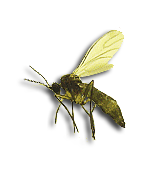FungUs Gnat
|
General Characteristics: - Usually 5mm or less. (1-11 mm) - Larvae have smooth semi-transparent skin revealing digestive tract contents. Reproduction: - Females lay 100-150 eggs in their 2- to 5-day existence - Eggs hatch in 3-5 days and the larvae begin to feed immediately on organic matter near the soil surface - Larvae reach maturity in about 2 weeks when they cease feeding, spin silken cocoons and pupate - The pupal stage lasts less than a week - The entire life cycle only lasts 4 weeks at greenhouse and house temperatures - Overlapping generations can be present at the same time Signs of Infestation: - Moist, shady places are preferred - Larvae found on fungi, decaying vegetation, or plant roots - Sometimes abundant enough to form a crawling mass of several inches across and several feet long - They can be pests in green houses or around potted plants Control Techniques: - Check plant potting soils and dispose of infested material accordingly - Remove moisture from wet areas to eliminate breeding areas “Ohio State University Extension Fact Sheet (Entomology)- Fungus Gnats” (On-line). Ohio State University Entomology. Accessed Jan. 14, 2010 at http://ohioline.osu.edu/hyg-fact/2000/2114.html. “Family Sciaridae (Dark-winged Fungus Gnats)” (On-line). Iowa State University Entomology. Accessed Jan.
|


